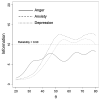PROMIS® Parent Proxy Report Scales: an item response theory analysis of the parent proxy report item banks
- PMID: 21971875
- PMCID: PMC3791923
- DOI: 10.1007/s11136-011-0025-2
PROMIS® Parent Proxy Report Scales: an item response theory analysis of the parent proxy report item banks
Abstract
Objective: The objective of the present study is to describe the item response theory (IRT) analysis of the National Institutes of Health (NIH) Patient Reported Outcomes Measurement Information System (PROMIS(®)) pediatric parent proxy-report item banks and the measurement properties of the new PROMIS(®) Parent Proxy Report Scales for ages 8-17 years.
Methods: Parent proxy-report items were written to parallel the pediatric self-report items. Test forms containing the items were completed by 1,548 parent-child pairs. CCFA and IRT analyses of scale dimensionality and item local dependence, and IRT analyses of differential item functioning were conducted.
Results: Parent proxy-report item banks were developed and IRT parameters are provided. The recommended unidimensional short forms for the PROMIS(®) Parent Proxy Report Scales are item sets that are subsets of the pediatric self-report short forms, setting aside items for which parent responses exhibit local dependence. Parent proxy-report demonstrated moderate to low agreement with pediatric self-report.
Conclusions: The study provides initial calibrations of the PROMIS(®) parent proxy-report item banks and the creation of the PROMIS(®) Parent Proxy-Report Scales. It is anticipated that these new scales will have application for pediatric populations in which pediatric self-report is not feasible.
Figures


References
-
- Reeve BB, Hays RD, Bjorner JB, Cook KF, Crane PK, Teresi JA, et al. Psychometric evaluation and calibration of health-related quality of life item banks: Plans for the patient-report outcomes measurement information system (PROMIS) Medical Care. 2007;45(Suppl 1):S22–S31. - PubMed
Publication types
MeSH terms
Grants and funding
LinkOut - more resources
Full Text Sources
Medical

